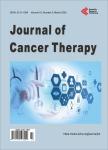Correlation between the Changes in Lung Function and Lung Density Changes in Patients Following Radio- (Chemo-) Therapy for Thoracic Carcinomas
Correlation between the Changes in Lung Function and Lung Density Changes in Patients Following Radio- (Chemo-) Therapy for Thoracic Carcinomas作者机构:Clinic for Radiotherapy and Radiation Oncology University Clinic Giessen and Marburg Marburg Germany Clinic for Radiation Oncology Universitatsspital Zürich Zürich Switzerland Clinic for Radiotherapy and Radiation Oncology Ruppiner Kliniken GmbH Neuruppin Germany
出 版 物:《Journal of Cancer Therapy》 (癌症治疗(英文))
年 卷 期:2019年第10卷第3期
页 面:257-267页
学科分类:1002[医学-临床医学] 100214[医学-肿瘤学] 10[医学]
主 题:Lung Thoracic Neoplasms Radiation Injuries Pulmonary Fibrosis Lung Function
摘 要:Purpose: In this analysis we focused on the correlation of patients’ lung function (PFT) data and lung density changes (ΔHU) detected in follow-up CTs. Material and Methods: PFT and lung function data were available for 58 patients 12 weeks and 47 patients 6 months after radio- (chemo-) therapy for thoracic carcinomas (NSCLC, SCLC and esophageal carcinoma). The follow-up CT scans were matched with the planning CT scans of each patient and then subtracted to calculate ΔHU for each voxel using customized research software. PFT data regarding e.g. vital capacity (VC), total lung capacity (TLC) and diffusion capacity for carbon monoxide (DLCO) were collected before and at several follow-up appointments after treatment. Results: 12 weeks after therapy there was a statistically significant correlation between difference in DLCO and the maximum ΔHU as well as the difference in TLC and the minimum ΔHU. 6 months after treatment there was a significant correlation between the difference in VC and DLCO with numerous lung density parameters, e.g. the mean and median lung density changes and the 75th percentile of ΔHU. There was no significant correlation between the PFT parameters FEV1, pCO2 and pO2 and any lung density parameter at any follow-up appointment. Conclusion: There is a significant correlation between DLCO and ΔHU 6 months after treatment that most likely reflects the underlying pathological mechanisms in terms of the development of fibrotic lung tissue after RT. The relevance of the significant correlations 12 weeks after RT is questionable.



